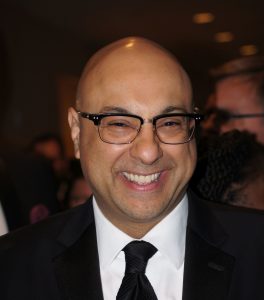He’s been coming into your home for years, via the television airwaves, so that familiarity probably makes you feel like you know him. Well, I do. I met Ali Velshi before he became The Ali Velshi. We are both from Toronto and met on a special council of high school student government representatives. Then our paths crossed again when we both attended Queen’s University in Kingston, Ontario. We stayed in touch post-Queen’s, back in Toronto, and then Ali moved to the U.S. And that brings us to today and Ali’s pursuit of the truth and a lecture he gave at Queen’s in March 2020, before Canada went into lockdown mode.
Ali made a lot of points in his lecture that resonated with me. If you want, you can read excerpts from the lecture here. He talks about fake news – a topic he explored as early as 2015 in a Tedx Talk – and he says that back then he realized posting fake news was lucrative for the publishers who would attract more readers, more clicks and therefore more advertising dollars. Then it occurred to him that it could also be used “to influence people’s thoughts politically.” We have learned a lot since then.
There is misinformation and there is disinformation. As Ali explains it, there is intent with disinformation. He says “Disinformation is somebody deliberately putting out bad information.” Hmm, who does that make you think of? Misinformation is when someone shares that bad information, by word of mouth or on social media, because they believe it. As Ali states, both are dangerous and sometimes the same person says a lie and then consciously spreads it. He has witnessed this many times in his career. Fact-checking is how you combat misinformation and disinformation.
Which brings me to something I’ve been doing lately: fact-checking my friends on Facebook. I’m not trying to be “that person,” but I’ve occasionally seen friends share information that I’ve questioned. The first thing I do is investigate. Are other reliable sources sharing the same information? If so, my sleuthing ends. But when I am reasonably sure the friend is sharing fake news, I tell them. It doesn’t happen often – my friends are smart and savvy – but I think we all have a moral responsibility to not share false information on social media. And I believe they do as well and have responded positively to my comments. (I haven’t been blocked as far as I’m aware!)
Why does it matter? If a friend posts or retweets fake news we have the option to just ignore it. Well, Ali reminds us that “now, it’s about politics. It’s about power. It’s about wars. It’s about coronavirus. […] If you go to the wrong sources, they will tell you to drink bleach, which, I suspect, will kill the coronavirus. And you. It will kill you.” Do you want that on your conscience?
If you want to share a reliable resource on COVID-19, the University of Toronto (UofT) has created an online guide for members of the university community doing research on the coronavirus, but it is accessible by anyone. Vincci Lui, a UofT librarian, also provides useful tips on how to spot misinformation about COVID-19. You can read why there is need for such a resource here.
There are many, many influential people who have made it their mission to debunk misinformation and disinformation. They are doing a fantastic job, but they can’t do it alone. We should all be trying to stop the dissemination of fake news – whether it’s about drinking bleach to prevent coronavirus or that stem cells can treat every ailment under the sun. I like this list from Jason Woolford on what scientists can do to help, found here.
Some quick tips for communicating science:
- Double check your facts. You can’t beat fake news by being fake news.
- Present facts in layman’s terms as much as possible.
- Make the fact more compelling and interesting than the lie. Focus on the human story of the science.
- Point out the lack of rigor and fallacies of the fake fact as well as the techniques that are used to distort reality (e.g. fake experts, cherry picking, logical fallacies).
- Emphasize the breadth and depth of scientific consensus that unpins current knowledge.
- Avoid hype. While confidence in scientists is high, hype runs the risk of undermining science in the long term.
- Use visual tools and aides – graphics, audio and video content can be more powerful than words alone.
Tim Caulfield would add that research has shown that if you deliver your message in an authentic, humble way you will be perceived as credible and believed. I know this because he says it in a conversation with the McGill Office for Science and Society, in a video published yesterday on combatting misinformation, and much more. Please watch.
Stacey Johnson
Latest posts by Stacey Johnson (see all)
- Right Turn: Stem cell supplements: A growing market with growing risks - December 19, 2025
- Right Turn: Beyond the ’stache: The science, the progress, the promise - November 26, 2025
- Right Turn: Can Bryan Johnson live forever? Will regenerative medicine help him do so? - October 10, 2025







Comments